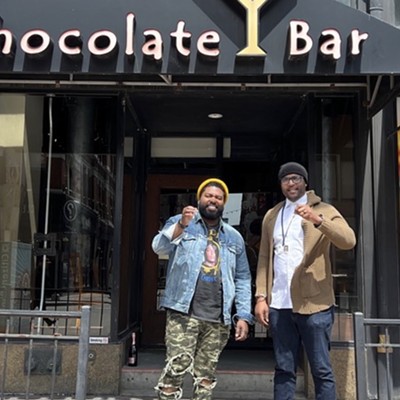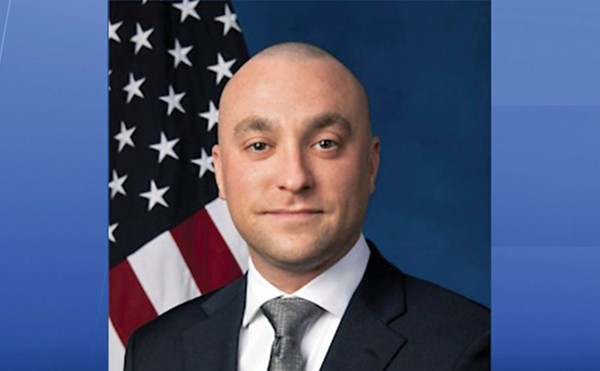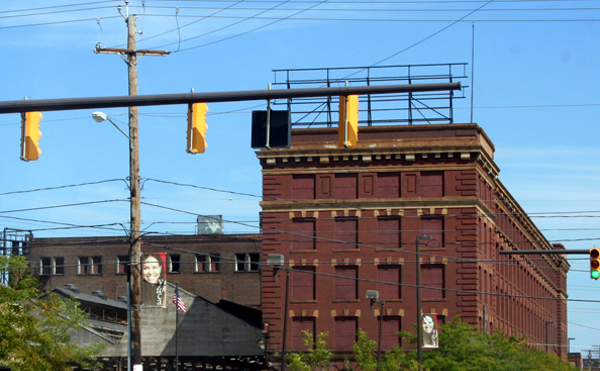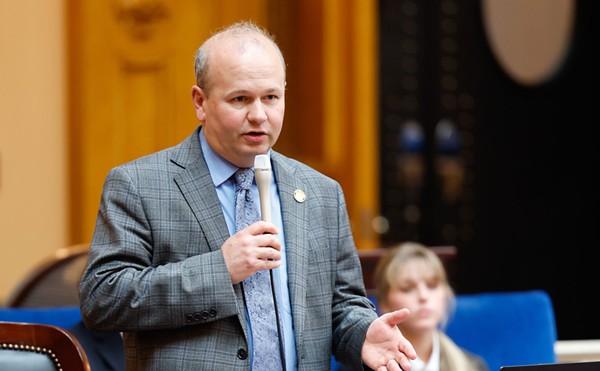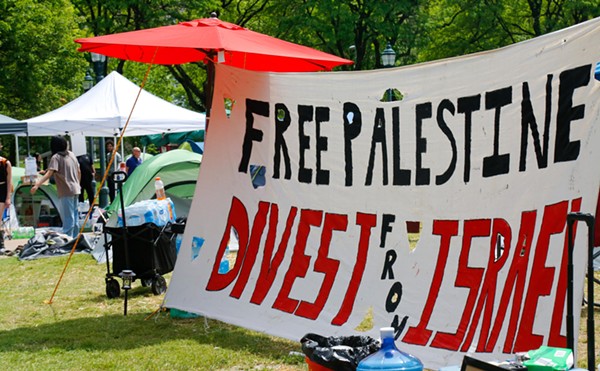She called Goode, gripped with the worry that afflicts the friends and families of cops. When he didn't answer, she called the Fourth District, where he was two hours late for work. Another first.
Sgt. Randall Burgeon privately feared the worst. His friend had seemed more stressed lately, "kind of like a steel coil." Burgeon needed little prompting from the lieutenant on duty to drive out to Goode's Highland Heights home and check on him.
When he pulled onto Goode's street, Burgeon saw Rozell walking Goode's fluffy Pomeranian, Coco. She had a key to Goode's house and entered, Rozell explained, but hadn't noticed anything unusual except the dog, unusually desperate to be let outside.
Fighting off the nagging "police sense" that something was wrong, Burgeon decided to take a closer look. As he walked through the quiet, shade-drawn house, Rozell hung back, slightly unnerved, watching him open up closet doors in search of her neighbor.
Burgeon remembers feeling unsettled as well.
"On the table, I saw all of Gerry's study material [for the lieutenant's exam] was open, and there was a light on," he recalls. "I went into the den, because he spent a lot of time there. I took a quick glimpse and didn't see anything. But that police sense said something's wrong. So I looked again, and I saw him lying on the floor.
"The first thing I thought was, Why is he on the floor asleep? . . . I called out his name as I walked toward him. The next thing I thought was, he had had a stroke or a heart attack. Then I looked at his face.
"If you've seen dead people before, they have a certain pallor to their skin. He had that. His eyes were half-open. I went to shake him, and he was ice cold."
In the dark house, Burgeon didn't see the single bullethole in Goode's T-shirt, just over his heart, nor the little splotch of blood on the carpet. The gun was obscured by an afghan partially covering his body. Burgeon called 911.
"Him shooting himself didn't enter my mind," Burgeon says. "When I heard one of the EMS people yell, "We have a gunshot wound,' you could see all of our knees start to buckle."
Five officers from the Cleveland Police Division, including Fourth District Commander Michael McGrath and Roy Rich of the Fraternal Order of Police, rushed to Goode's house. Soon, a wave of grief, speculation, and paranoia swept through the entire department. Many of his colleagues didn't want to believe that a take-charge officer like Goode, the "self-proclaimed junkyard dog," would take his own life. But there was something even more troubling fueling their skepticism.
Because of some comments Goode had made a few months earlier, during a meeting of black police supervisors, he had become a central figure in a controversial investigation of racism in the CPD. The investigation triggered such deep suspicion that another officer called Rich, urging him to make sure Goode hadn't been murdered. Rich himself wondered just how far someone might go to silence the outspoken sergeant and told the Highland Heights police, who were investigating Goode's death, about the investigation.
During his 20 years on the force, Goode, a light-skinned black man, had developed a reputation for being vigilant against racism. So it wasn't surprising when he spoke up at the supervisors' meeting, held in mid-July of 1999. A number of race-sensitive issues were discussed at the meeting, including one commander's concern that some white rookies were sporting "skinned heads." Goode asked whether the other supervisors had seen anyone wearing a suspicious pin, like the one he had spotted on a white officer in the Fourth District. No one had.
That should have been the end of the issue. But someone at the meeting relayed the observation about the pin to Mayor Michael White. One week later, his press secretary tipped off The Plain Dealer that she had "pretty good" information that there were "white supremacist organizations in the police department." With the city already in a heated debate over the impending visit of the Ku Klux Klan, the suggestion that the CPD was harboring white racists hit like gasoline on open flames.
White held a volatile press conference on July 22 calling for an investigation. It was widely perceived as a thinly veiled political maneuver, a counterattack against the police unions, who were criticizing White for being too accommodating to the Klan. The mayor justified the investigation by explaining that "a person of rank" in the Fourth District had confronted officers wearing "racist pins," among other equally vague allegations.
Although Goode was not identified by name, many in the department knew the mayor was talking about him -- a devastating blow both personally and professionally, friends and family say. His genuine concern for the department was now being manipulated by the mayor in his raging battle with the police unions. It upset Goode even more that some officers thought he was a mayoral snitch.
Goode tried to set the record straight with officers, other supervisors, even two of the mayor's top aides. But the investigation pressed forward. And rumors that Goode was the mayor's secret informant continued to spread.
The investigation was completed on September 11, 1999. It vindicated both the police department and Goode. But it wasn't released until March 26, 2000 -- and by then it was too late.
Goode killed himself on October 29.
The trumped-up racism charges were by no means the only difficulty in Goode's life. Friends and family say he had faced a number of emotional stressors and, like many policemen, tended to keep them bottled up. But being caught in the middle of one of the most jarring internal investigations in CPD history almost certainly helped propel him toward his fate.
"This was a brick he was carrying on his back," Rich says. "Whether it was the first brick or the last brick, it's still a brick he shouldn't have been carrying . . . People around Gerry knew it was a bunch of crap. But it's an 1,800-person department. There were people who don't know him and patrolmen he's had run-ins with, walking around thinking he was the one who started this and didn't do anything to stop it -- even though he had."
Rich is adamant: "Anyone who had knowledge that this was a limited situation and not racial, and didn't make a statement about it at the time, has blood on their hands. And they have to live with it."
Despite lingering doubts among his family and friends, Goode's death was ruled a suicide. Because he didn't leave a note, what made him take his life can never be definitively known. But he did leave clues for the people closest to him, as well as in a paper trail documenting his law enforcement career. Once a proud, enthusiastic cop, Goode self-destructed on his 20th anniversary as a Cleveland police officer. His is a story of shattered ideals and tragic disillusionment.
On a recent afternoon at the Justice Center, three of Goode's friends confided that he didn't need to leave a note. Those who knew him best could read his intent in how he ended his life. Of the two .38s he owned, one was not police-issued -- the one he used to put a bullet in his chest.
Goode always said the job "broke his heart." He didn't use his police gun, Burgeon says, because "he didn't want to give the department the pleasure of killing him twice."
The Monster Under the Rock
Gerry Goode never wanted to be anything other than a cop, from the time he was a little boy until the day he died. By then, the idealistic 23-year-old rookie who entered the force eager to serve and protect had become a 43-year-old desk sergeant, plagued with stress-related back pain and an inability to relax. His family suggested moving or trying a new line of work. But Goode said he couldn't imagine doing anything else. Policing didn't make him happy, but it was his one great love. He couldn't let it go.
There were lesser objects of affection -- the perpetually shiny Fiat Bertone X1/9 he called his "Malcolm X1/9" and the house in a mostly white suburb that he was constantly remodeling. Goode frequented the City Club and the Cleveland Orchestra. His personal life, however, remained devoid of any significant emotional attachment. He hadn't had a steady girlfriend in a year and a half, and he was fairly distant from his family.
Relatives and friends say Goode often felt as if he didn't belong. He was adopted and suspected he was biracial, although he never did track down his birth parents. Still, his light skin was distinctive, especially growing up in Cleveland in the racially turbulent '60s and early '70s.
"He used to say he was too white for the blacks and too black for the whites," says the executor of his will, a white man who was probably his closest friend.
Six months after his death, three of Goode's friends -- a patrolman, a sergeant, and an employee of the city prosecutor's office -- still feel his absence in the "stepchild" district, as the Fourth is often called. Crowding around a small table in the Justice Center, their memories gush, but there are no tears. Like Goode, these are tough guys. They revert to laughter instead, endearingly mimicking Goode's stiff mannerisms and clipped, drill-sergeantesque voice.
He has visited them all in dreams, they say, most recently admonishing one for agreeing to speak with a reporter. If he wanted the whole world to know why he killed himself, Goode barked, he would have left a note.
Goode did things by the book and expected the same of everyone else. He was diligent in his middle-management, largely administrative job -- hardly a prized position, especially in the ill-reputed Fourth. He turned down opportunities to leave, including a job with the vice squad, reportedly because he considered the atmosphere there too loose.
The young patrolman says he still has one of the red felt-tip pens Goode used to correct his incident reports. "He would make a dot next to everything that was wrong," he recalls. "Then he would send it back to you, even if you just missed a dash."
Despite his rigidity, Goode had soft spots. There was the time, one month before his death, for instance, that he took charge of a troubled child who had been abandoned at the station. Goode talked to him at length about his behavior, then drew up a contract that he, the boy, and two witnesses signed.
"I, Deangelo, promise to complete my schoolwork, and not be disruptive in school. If I do my schoolwork, and get grades no lower than a C, Sgt. Goode of the 4th Police District will donate a round-trip Greyhound Bus ticket to Moorehouse College if I, Deangelo, am given permission to visit my cousin."
That was classic Gerry, says Dave Kammerman, a friend from the city prosecutor's office who worked with Goode. He would help anyone who needed him and didn't wait to be asked. By all accounts, Goode was a straight arrow -- ethical, intelligent, and genuine.
"He was just good," says Commander Michael McGrath of the Fourth District. "He'd have been good in a bank, wherever he worked. The guy just did his job, was very articulate. If I had a business, he's the first guy I'd hire."
Friends met news of his death with disbelief. Goode gave the impression that he could handle anything. Unlike many officers who commit suicide, he had no alcohol, drug, or money problems. He had just bought a new car. He was studying to take the lieutenant's exam. And he had plans to do more remodeling on his house.
But from a vantage point of six months, Goode's friends say the signs of his depression now seem painfully clear. In the weeks before he died, Goode seemed increasingly crabby and preoccupied. Never a social mixer, he had stopped going out with friends after work entirely. At the same time, he was calling people who had squabbled with him in the past and making peace. He was letting his work buddies know he considered them friends.
Burgeon remembers almost every word of a conversation he had with him on October 26, Goode's last day at work.
"I was talking to him in the locker room, and I said, "Gerry, how are you doing?'" he recalls. "He said he was OK. I said, "I'm concerned. You're really irritable and hard to talk to. There are people who care about you.' He stuck out his hand and said, "Thank you for caring.'"
Goode declined other offers of help. Burgeon and Kammerman say staff from the Employee Assistance Unit, the mental health arm of the department, came down to talk with Goode several times. He assured them he was fine. It was the rest of the world that was screwed up.
"People are looking for the monster under the rock," Burgeon says. "They might just find that it's Gerry."
Epidemic in Blue
It's not uncommon for police officers in emotional distress to hide it from others. Officers are taught to be strong, decisive, and in control at all times. Many wouldn't consider revealing any sort of psychological trouble to family or friends, because they don't want to burden them. Mentioning it to the department psychologist could mean getting taken off the street and possibly compromising their careers.
Depression and despair among officers tend to worsen during corruption investigations, says John Violanti, a former New York state trooper and author of Police Suicide: Epidemic in Blue. Police suicides increased during the Tammany Hall corruption scandal in New York City in the 1930s and again during a drug scandal in 1994. Twelve NYPD officers killed themselves that year, as many as five of whom were involved in the investigation. Recently, Violanti has been watching the embattled Los Angeles Police Department, predicting the next wave of suicides will happen there.
"Police officers are a cohesive group," says Violanti, an associate professor of criminal justice at the Rochester Institute of Technology. "They're proud of their job, and they stick together. If someone gets into a corruption scandal, they may feel shame. They may feel they've let the department down. Sometimes that's a precipitant for suicide . . . I almost compare it to the hara-kiri stuff. I'm going to sacrifice myself because I've brought shame on my country, or something like that."
Even though the police suicide rate is currently at least twice that of the general population, the subject is still taboo in most departments, Violanti says. Police officials fear it will bring shame, negative publicity, or even liability upon them. Like many departments, Cleveland does not even keep track of how many officers take their own lives. The sad truth remains, however, that just about every cop will have to confront the issue at some time.
In his 18-year career, Burgeon says he knows of about 10 Cleveland officers who have committed suicide. Commander McGrath knows of at least seven. For Roy Rich, Goode was the second close police friend to take his own life. The first was his former partner.
That anecdotal evidence supports the data compiled by Robert Douglas, executive director of the National P.O.L.I.C.E. Suicide Foundation, who says officers are killing themselves two to three times faster than they are being killed in the line of duty. According to his figures, which come from a variety of sources, including the National Police Memorial Committee, 386 law enforcement officers killed themselves last year, up from 350 in 1998.
"It's like an epidemic," he says. "It is a cancer that is eating the law enforcement family from the inside out."
That's why researchers like Violanti have begun examining the personal and work histories of police suicide victims. The so-called "psychological autopsies" may result in departments being able to spot suicidal behavior and intervene before it's too late.
A Troubled History
Like many police officers who kill themselves, Goode had a track record of problems that attracted the attention of his superiors. In his personnel file, two complaints from the last five years rest at the bottom of a thick stack of thank-you letters and commendations, including the 1993 Distinguished Service Medal for helping solve a homeless woman's murder. A review of those two complaints, and older ones introduced as evidence in a 1990 court case, indicate that Goode had, at times, given his superiors reason to question his emotional stability.
"I have reviewed his personnel file and have found incidents of questionable behavior, which seem to occur when he is involved in stressful situations," concluded then-Lieutenant Rocco Pollutro about Goode in 1990.
Pollutro's comments stemmed from a shooting incident that led to a lawsuit filed against Goode. According to an investigator's report, Goode had been in a high-speed chase with the driver of a stolen truck. Once the truck stopped, Goode approached the driver's side with his shotgun drawn. He banged on the rolled-up window with the gun, occasionally pointing it at the driver, and unintentionally fired a pellet into his eye. The shooting was later ruled accidental. The case was dismissed. But Goode was disciplined by the department.
He was also sent for a psychiatric evaluation. The psychiatrist wrote that Goode had "no significant psychopathology at this time," adding that "he appears to be highly motivated and dedicated to his profession." The psychiatrist recommended he be returned to street duty.
Out of 30 complaints dating back to 1980, Goode's superiors substantiated only one -- an incident in which Goode was accused of being disrespectful to a juvenile victim of an assault. Several superiors did note problems with Goode's attitude, however -- specifically, his tendency to get overly excited, even belligerent. Personnel records show that he was sent to sensitivity training twice and for psychological evaluations twice. He was suspended at least once, in 1988, for fighting with another cop while on duty.
The last complaint on record was filed by the chief city prosecutor in 1997, accusing Goode of steadfastly refusing to track down two subpoenaed patrolmen when they didn't show up for court. She also charged that Goode yelled and screamed at the assistant prosecutor who asked him to do so. Goode denied any wrongdoing and suggested that the chief prosecutor was retaliating for an earlier complaint he had filed against another assistant prosecutor.
The investigating officers were unswayed by Goode's argument. In fact, Captain Luis Cumba recommended that Goode be counseled by his commander about his "theories involving the Municipal Prosecutor's office" and indicated that "Sergeant Goode has had a lengthy history of complaints that appear consistent with conduct displayed in [this] incident."
His complaint history notwithstanding, Goode was considered a consummate professional by fellow officers. Barry Withers, an executive assistant to the mayor who oversees public safety, says he was "heartbroken" when he heard Goode killed himself.
"Sgt. Goode was, from what I've seen, a good police officer," he says. "He had a great reputation, and I think he had a great deal of integrity."
One reason that Goode stacked up complaints is because he was unyielding. He believed in the rules and had little patience with those who tried to bend them, including a woman Goode stopped for a traffic violation in 1987. The woman tried to get out of a ticket by flashing her FOP card, which he promptly confiscated. The most well-known Goode antagonist was a medical doctor he arrested outside the Greyhound bus terminal in 1991, for an outstanding warrant on a traffic citation.
Despite the doctor's insistence that she be given special treatment, he hauled her out of her car and down to the jail. She filed a police brutality complaint against him the next day. Always adamant about protecting his reputation, Goode filed a libel lawsuit against her. She filed a counterclaim, and both ended up on WKYC-TV/Channel 3 as subjects of an investigative series, "Docs, Cops and Videotape."
Luckily for Goode, the camcorder in his squad car was rolling during the doctor's arrest. Most felt it cleared him of the brutality charge. But in a court document, Goode complained that the television segments -- airing in the wake of the Rodney King fiasco in Los Angeles -- had left many people thinking he was a bad cop. It bothered him for a long time.
"Gerry didn't know how to let go of things," Burgeon explains. "He could tell you every negative experience he ever had, the time of day it took place, and the color of the clothes you wore."
After 20 years, those negative experiences had him at the breaking point.
The Word According to Goode
It was just a few weeks before the KKK came to town that Goode found himself in an unusual position -- sticking up for the subjects of racial allegations. Goode was used to lobbing racial complaints, not fighting them.
When he lost his job as a retail security agent in 1976 for "unsatisfactory job performance," Goode filed a racial discrimination lawsuit in federal court. "That termination was the only time I have ever had a bad mark on my job record," he wrote in his 1979 application to become a Cleveland police officer. "And I intend to correct that injustice."
Goode's sensitivity to racial matters continued when he joined the force. His nephew, Erik Myles, says Goode talked about racism in the department for as long as he can remember. When he sat for an interview with Sgt. James Muhic of Internal Affairs on August 12, Goode recalled seeing racist graffiti in the department as recently as 1997.
"I did not take the commander, to the best of my knowledge, upstairs," he said. "But the men's restrooms were heavily graffitied, including swastikas, statements such as "If black is beautiful, then I just shit a masterpiece.'"
Goode suggested that the commander have it cleaned up, which he did. But Goode complained about other racial problems, according to friends, including a recent run-in with a white patrolman who allegedly disrespected him. Goode was frustrated because his supervisors wouldn't back him when he tried to discipline the officer.
His friends in the district say Goode often expressed frustration with the way the command staff addressed his concerns. He wasn't always taken seriously, possibly because some thought he had a tendency to exaggerate.
"If you know Gerry Goode, you know when you hear him talking, you take a grain of sand with a grain of salt," Commander William Tell told Internal Affairs. "You don't take everything this guy is saying as gospel."
Which is why Tell and other supervisors were surprised to hear a version of Goode's comments from the meeting being disseminated for public consumption. Goode learned of the meeting by accident, from another supervisor he happened to see in a barber shop. As Goode recalled in his interview with Muhic:
"He says, "Well, are you going to be at the meeting tomorrow?' And I go, "What meeting?' And he said, "The meeting at Bishop Ellis's Church.' And I said, "Well, I don't know anything about it.' And he said, "It's the black supervisors meeting to have a response to the KKK rally.'"
About 40 supervisors showed. A variety of topics were discussed. One commander expressed his concern that white rookies were coming out of the police academy with "skinned heads." Then Goode asked if any of the supervisors had seen the odd pin.
"I was asked what it was," he said. "I gave an explanation. It was a small circle with eight radials coming out of it . . . on a white metal colored pin I saw an officer wearing at the Fourth District."
Goode recalled telling the group he thought it signified an "anti-government" group.
When the pin surfaced in headlines a week later, it had multiplied and become one of several racist insignias and activities allegedly rampant in the department. White vowed a full investigation, essentially declaring war on the police. Not coincidentally, the charges helped shore up White's faltering support in the black community, where he was being criticized for coddling the Klan.
From the officers' viewpoint, they were being used. White's press secretary had leaked half-baked rumors to the media, propagating serious allegations with no substantiation. This, after hundreds of officers had demonstrated in front of the Justice Center just weeks earlier, demanding that the mayor improve their equipment and increase their pay. This, after the mayor announced he was considering allowing the Ku Klux Klansmen to dress in the police garage.
The day after the press conference, Goode received a call from the mayor's office. Barry Withers and LaVonne Sheffield-McClain, White's chief of staff, wanted to meet with him. Withers says there was nothing clandestine about the meeting. But the manner in which it took place -- in a car on a downtown street -- seems like something out of a bad spy movie. Withers and Sheffield-McClain parked on Huron Avenue. Goode pulled up behind him, then climbed into Withers's backseat.
What they talked about during that 15- to 30-minute meeting remains in dispute. Withers claims Goode supported the racist pin allegation. Goode "thought the pin could be associated with a racist group," Withers says.
In his interview with Muhic, Goode admitted he did think, at one time, that the pin could be racist. But by the time he met with Withers, he said, he had already researched the pin and found no evidence of a racist link. Goode characterized his meeting with Withers and Sheffield-McClain as simply trying to correct the misinformation in the media -- something Withers does not recall.
"Pin is singular," Goode said. "Pins is plural. And I pointed it out to [the mayor's aides] that I only said there was one officer . . . It wasn't to cast dispersions [sic] on anyone. It was only to make people aware of it. [The black supervisors] were saying that people with short haircuts were racist. Which I don't necessarily think is a good indication, but I said, "Has anybody seen anything else? I saw this pin, maybe we should see if there's other people wearing it. Has anybody else seen it?' Nobody indicated they had seen any other officers wearing it."
Although Goode tried his best to undo the damage the allegations had caused the department, Rich says the sergeant still felt betrayed by whoever leaked his statements. And the adverse publicity was taking a heavy personal toll. Goode felt that other officers regarded him as the mayor's informant. He also believed that his current predicament would haunt him in the future.
To Goode, even talking openly to Internal Affairs made him a marked man. In a tape of the interview, Muhic asks, "Were you intimidated or threatened with retaliation for coming forward in any way?" Goode pauses for a long 12 seconds before answering, "No."
"Do you feel that you might be putting your career or job status in jeopardy by speaking openly in regards to any of the topics we've discussed?"
"Yes."
Desperate for vindication, Goode ended the interview assuring Muhic that "I'm trying to clarify the misstatements or inaccuracies as published in the media . . . I did not want to be divisive."
By then, it didn't matter what he wanted. There were larger forces at work. And he was just one cop.
The Aftermath
After Goode's body was discovered, Rich accompanied the Employee Assistance Unit to the house of his closest relative, a sister in Bedford, to tell her about her brother's death. But with results of the Internal Affairs investigation still veiled, Cleveland police were tight-lipped.
That silence cost the CPD the family's trust.
"When I came up there, I couldn't talk to anybody," recalls Denise Myles, Goode's other sister, who lives in Memphis. "I tried to talk with the CPD. They were in contact with my sister, but they wouldn't talk to me. I put in calls, and they wouldn't call me back. I really, to this day, don't know what went on."
The police report from Highland Heights indicated that the death was a suicide. But Detective Ken Visoky says his department didn't officially close the case until December 9, when he was informed that the county coroner had come to the same conclusion. In the meantime, Denise became more suspicious and upset. She replayed in her mind the last day she spent with her brother, shortly before his death.
"We spent a whole day at his house, basically talking about old times and growing up," she says. He didn't seem depressed, but there was one odd thing about the visit that she remembers. He told her about a "case" and a "cover-up" involving racism in the police force.
"He didn't want to give us any details, because he said it was too dangerous for us to know," she says. "To be honest with you, he was afraid for his life."
After Goode's body was discovered, Denise's 25-year-old son, Erik, came back to Cleveland with his mother. He says he studied the police report and asked so many questions that Highland Heights detectives became irritated with him. To this day, he's still not satisfied with their investigation, especially with the fact that the CPD reportedly had access to the crime scene after it was sealed off. Cleveland Police Chief Martin Flask will not answer questions about Goode -- not even to confirm or deny rumors that the CPD did its own investigation into his death.
"You should have seen the way Cleveland treated us," says Erik, who until recently had always wanted to be a police officer, like his uncle. "They didn't send flowers. They didn't say they were sorry we lost him. The looks they gave us at the memorial service was that something was not right."
Goode's memorial service was packed with officers in uniform. The police chaplain attended; so did Chief Flask, Goode's former commander, who also gave a speech. It's likely the negative vibe the Myles family picked up had nothing to do with conspiracy and everything to do with the awkwardness with which officers deal with the suicides of their brethren.
"His friends and his family suffer from that, because no one wants to talk to them, and they're all afraid to say anything," Violanti says. "Generally, when there's a suicide in a department, there's a lot of anger and a lot of guilt, because the officers don't know where to put the blame . . . They don't know whether it was their fault or his fault. Maybe they should have seen it. Maybe they should have recognized that he had problems, and maybe they could have stopped this."
Sgt. Goode's Legacy
When the Internal Affairs report was finally released in March, all of Cleveland learned that there was no organized racism in the police department.
The unions unleashed a great chorus of "Told you so!" The White administration couched the report in a ream of racial profiling statistics, as proof that the department still has a long way to go in the area of race relations. Meanwhile, news of Goode's death, and sketchy details of the role he played in this unfortunate drama, filtered out in a Sunday Plain Dealer story.
Goode's friends and family were livid. The way they saw it, his reputation had been forever tarnished as the instigator of damaging, baseless racial allegations. Some were struck by the irony. Of all the times in his life that Goode had spoken out against everyday instances of racial injustice, it was this manipulative non-issue that would become his legacy.
"There's a joke going around the Fourth District that they're getting ready to reopen the Kennedy assassination investigation, and Gerry's going to be the Lone Gunman on the grassy knoll, because he's not here to defend himself," Burgeon says. "The powers-that-be aren't going to come up with anything different, because it's easier for them to let Gerry take the blame than to say they screwed up."
Because Goode chose to die in the midst of the racism controversy, he and it will always be linked. Much has been said of the widening rift it created between the mayor and the police force, adding to the pervasive job dissatisfaction and disillusionment in the ranks. In the wake of Goode's death, it's apparent that police morale was not the only casualty.
But Goode's dedication to fighting racism lives on. After his estate is divided up among his family and friends, the remainder will go to a number of charities, including the Southern Poverty Law Center -- the nation's foremost monitor of hate groups.
Jacqueline Marino can be reached at [email protected].

